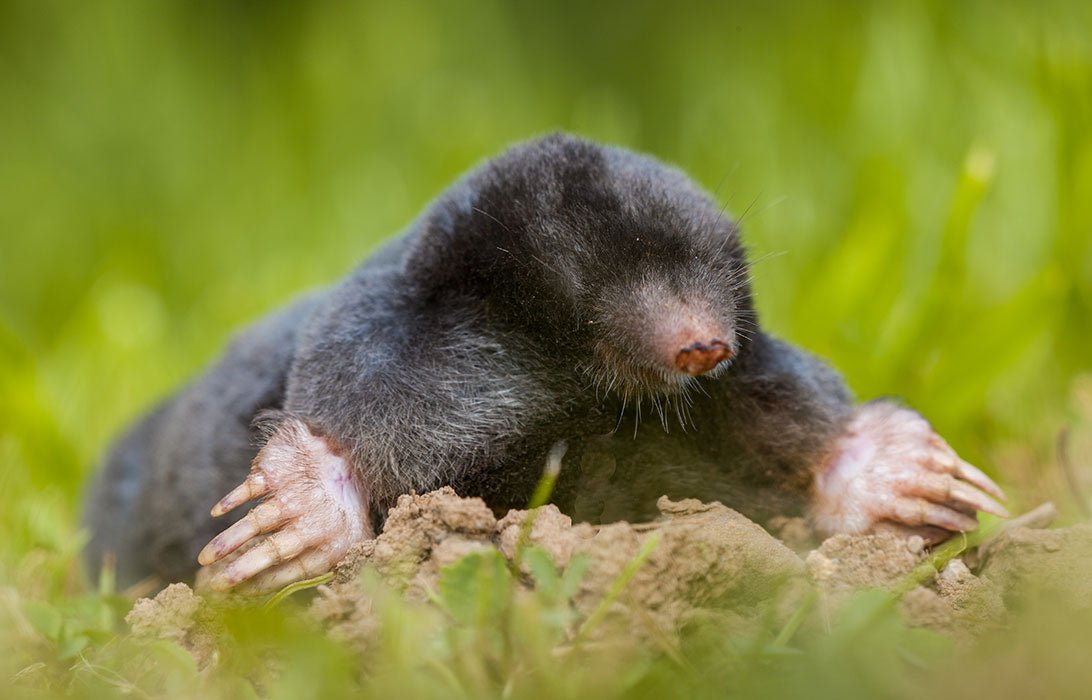
Many small animals live closely with humans. But some species, like mice and moles, can become problematic. These species are usually considered pests as they interfere with social activities, economic well-being, and agriculture (1).
One animal which does not live harmoniously with people is the mole. Moles are considered pests because they cause economic loss, increase the invasion of other pest species, and have dire consequences for agriculture (2).
The reason moles have such devastating consequences for people worldwide is that they are a “tunneling” species. Moles can tunnel across lawns, bowling greens, golf courses, cricket greens, gardens, and crop fields. While they do this, they throw up mounds, also known as molehills. In addition to impacting people’s livelihoods, molehills are aesthetically unattractive and a nuisance (3).
As a result, moles have become a well-known pest species, with many resources dedicated to their impact and controlling their spread. But what are moles? How can you get rid of them? Is there a way to control them without impacting other species or the environment?
What Are Ground Moles?
Moles are small mammals which spend the majority of their life underground. They tend to be distinguishable by their short, stout front legs, ending with rounded forefeet with “palms” facing outwards. Their feet are paddle-like and have nails that allow them to move freely through the soil (4).
In addition to their distinguishable forelegs, they lack external ears and have incredibly small eyes. They cannot see well and can only differentiate between light and dark (5).
Moles like moist soil and construct extensive underground passageways or tunnels. They make large cavities to nest in underground. In addition to their nests remaining underground, they also tend to eat many insects that can be found in the soil, including snail larvae, spiders, earthworms, and white grubs (6).
Moles can consume up to 36 kilograms of earthworms per year. The time they spend foraging for food has dire economic impacts for farmers and are a nuisance for homeowners (7).
Moles breed once per year, having two to five young from March to May. The young remain in the nest for four weeks, at which point they can leave and fend for themselves. Generally, moles are only noticed when their tunneling activity impacts lawns, fields, and gardens (8).
How Do You Get Rid Of Moles?
There are four practical ways to get rid of moles. These are insecticides, toxicants, fumigants/deterrents, and traps.
1. InsecticidesRemoving the primary food source of moles is one way to get rid of them. For example, one of their favorite insect species in the USA is white grubs. White grubs overwinter in the soil and come up to the surface in the spring.
Applying insecticides to the area when white grubs are maturing is one way to kill off the moles’ food sources. By controlling their food supply, you may be able to make them leave. However, before leaving, moles may increase their digging to find food, so you may end up with more damage before you have less (9).
2. Toxicants
Toxic bait can be used to control moles, but this method may not be the most efficient way.
Many toxic baits deliver the toxicant through grain, seeds, or nuts, which is a food moles do not typically eat. The other problem with toxic bait is the high chance it can kill animals you are not targeting. This problem is known as a secondary kill This is particularly troublesome as protected animals, such as endangered birds, can eat the bait (10).
3. Fumigants And Deterants
Another way to control moles is through fumigation. This is where toxic gas cartridges are used to deliver a lethal dose of a toxic substance. However, most of the time, this does not work well as the moles tunneling systems are typically too long and porous for gas to be effective (11).
This is where EcoClear’s MoleX™ comes in.

Using naturally derived ingredients, MoleX™ can continuously and humanely stress the moles using smell. As it is in pellet form, it can apply chronic olfactory stress to the moles, which can be easily replenished every 14 days or until your moles are gone.
4. Trapping
Trapping is the most popular and safest method of controlling moles. In addition to being effective, it completely minimizes secondary killing and is safer for the environment (13).
Trapping also produces carcasses that can generate an economic benefit through fur sale or its use for laboratory and biological experiments and analysis (14, 15). Trapping, however, is not for the faint-hearted.
The Bottom Line
Moles are a species well-known for causing havoc through tunneling and the creation of molehills. While not able to see or hear, this small mammal causes a significant financial burden across the world.
Several methods of getting rid of these pests include trapping, insecticides, toxicants, and deterrents.
EcoClear’s MoleX™ is an eco-friendly deterrent safe for you and the moles, helping them leave your yard for good.


